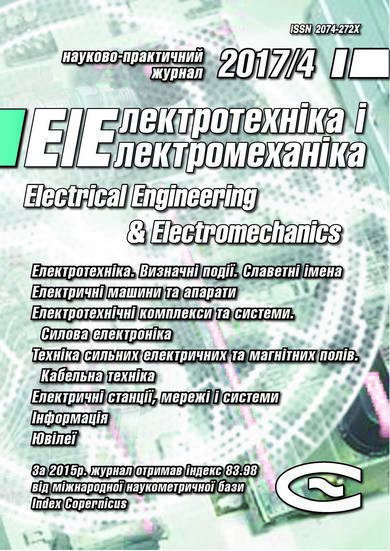THE DEVELOPMENT OF THE THEORY OF INSTANTANEOUS POWER OF THREE-PHASE NETWORK IN TERMS OF NETWORK CENTRISM
DOI:
https://doi.org/10.20998/2074-272X.2017.4.10Keywords:
network-centric technology, instant power, zero sequence, neutralAbstract
Purpose. Information technologies allow multidimensional analysis of information about the state of the power system in a single information space in terms of providing network-centric approach to control and use of unmanned aerial vehicles as tools for condition monitoring of three-phase network. Methodology. The idea of energy processes in three independent (rather than four dependent) curves vector-functions with values in the arithmetic three-dimensional space adequately for both 4-wire and 3–wire circuits. The presence of zero sequence current structural (and mathematically) features a 4-wire scheme of energy from a 3-wire circuit. The zero sequence voltage caused by the displacement of the zero voltage phases. Offset zero in the calculations can be taken into account by appropriate selection of the reference voltages. Both of these energetic phenomena with common methodical positions are described in the framework of the general mathematical model, in which a significant role is played by the ort zero sequence. Results. Vector approach with a unified voice allows us to obtain and analyze new energy characteristics for 4–wire and 3–wire circuits in sinusoidal and non-sinusoidal mode, both in temporal and frequency domain. Originality. Symmetric sinusoidal mode is balanced, even with non-zero reactive power. The converse is not true. The mode can be balanced and unbalanced load. The mode can be balanced and unbalanced voltage. Practical value. Assessing balance in network mode and the impact of instantaneous power on the magnitude of the losses, will allow to avoid the appearance of zero sequence and, thus, to improve the quality of electricity.
References
1. Sokol Y.I., Gryb O.G., Shvets S.V. Network centrism optimization of expeditious service of elements of the power supply system. Electrical engineering & electromechanics, 2016, no.3, pp. 67-72. (Rus). doi: 10.20998/2074-272X.2016.3.11.
2. Sokol Y.I., Gryb O.G., Shvets S.V. The structural and parametrical organization of elements of a power supply system in the conditions of network centrism. Electrical engineering & electromechanics, 2016, no.2, pp. 61-64. (Rus). doi: 10.20998/2074-272X.2016.2.11.
3. Shvets S.V., Voropai U. G. Mariechantal aspects of the use of unmanned aerial vehicles. Bulletin of Kharkiv Petro Vasylenko National Technical University of Agriculture, 2016, no.176, pp. 33-34. (Ukr).
4. Sirotin Iu.A., Ierusalimova T.S. Instantaneous and integral power equations of nonsinusoidal 3-phase processes. Electrical engineering & electromechanics, 2016, no.1, pp. 69-73. doi: 10.20998/2074-272X.2016.1.13.
5. Zhezhelenko I.V., Saenko Yu.L. Voprosy kachestva elektroenergii v elektroustanovkakh [Issues of power quality in electrical installations]. Mariupol, PSTU Publ., 1996. 173 p. (Rus).
6. Willems J.L, Ghijselen J.A. The relation between the generalized apparent power and the voltage reference. Energia elettrica, 2004, vol.81, pp. 37-45.
7. Shidlovskii A. K., Mostovyak A.G., Moskalenko A.G. Uravnoveshivanie rezhimov mnogofaznykh tsepei [Balancing the modes of multiphase circuits]. Kiev, Naukova Dumka Publ., 1990. 181 p. (Rus).
8. Korn G., Korn T. Spravochnik po matematike dlia nauchnykh rabotnikov i inzhenerov [Mathematical handbook for scientists and engineers]. Moscow, Nauka Publ., 1973. 832 p. (Rus).
9. Peng F.Z., Lai J.S. Generalized instantaneous reactive power theory for three-phase power systems. IEEE Transactions on Instrumentation and Measurement, 1996, vol.45, no.1, pp. 293-297. doi: 10.1109/19.481350.
Downloads
Published
How to Cite
Issue
Section
License
Copyright (c) 2017 Ye. I. Sokol, Iu. A. Sirotin, T. S. Ierusalimova, O. G. Gryb, S. V. Shvets, D. A. Gapon

This work is licensed under a Creative Commons Attribution-NonCommercial 4.0 International License.
Authors who publish with this journal agree to the following terms:
1. Authors retain copyright and grant the journal right of first publication with the work simultaneously licensed under a Creative Commons Attribution License that allows others to share the work with an acknowledgement of the work's authorship and initial publication in this journal.
2. Authors are able to enter into separate, additional contractual arrangements for the non-exclusive distribution of the journal's published version of the work (e.g., post it to an institutional repository or publish it in a book), with an acknowledgement of its initial publication in this journal.
3. Authors are permitted and encouraged to post their work online (e.g., in institutional repositories or on their website) prior to and during the submission process, as it can lead to productive exchanges, as well as earlier and greater citation of published work.





